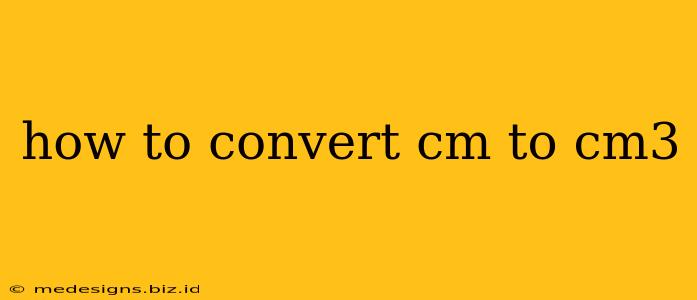Converting centimeters (cm) to cubic centimeters (cm³) isn't a direct conversion like converting between meters and centimeters. This is because cm measures length (one dimension), while cm³ measures volume (three dimensions). You can't directly convert a linear measurement to a volume measurement without additional information.
To understand why, picture a cube. If one side of the cube measures 1 cm, its volume is 1 cm x 1 cm x 1 cm = 1 cm³. This means you need the length, width, and height of a three-dimensional object to calculate its volume in cubic centimeters.
What you need to convert to cm³
To calculate the volume in cm³, you need the dimensions of the object in centimeters. These dimensions could be:
- Length, width, and height (for rectangular objects): Simply multiply these three values together.
Volume = Length x Width x Height - Radius and height (for cylinders): Use the formula:
Volume = πr²h(where 'r' is the radius and 'h' is the height). - Other shapes: There are specific formulas for calculating the volume of other shapes (spheres, cones, etc.). You can find these formulas online or in a geometry textbook.
Example Calculations
Let's look at a few examples:
Example 1: Rectangular Box
Let's say you have a rectangular box with:
- Length = 5 cm
- Width = 3 cm
- Height = 2 cm
The volume would be: 5 cm x 3 cm x 2 cm = 30 cm³
Example 2: Cylinder
Imagine a cylinder with:
- Radius = 4 cm
- Height = 10 cm
The volume would be: π x (4 cm)² x 10 cm ≈ 502.65 cm³
Common Mistakes to Avoid
- Direct conversion: Don't try to simply add zeros or multiply by a constant factor. This is incorrect. You need the three dimensions.
- Incorrect units: Make sure all your measurements are in centimeters before performing the calculation.
- Using the wrong formula: Choose the appropriate formula based on the shape of the object.
Beyond Basic Calculations
Understanding cubic centimeters is fundamental in various fields:
- Science: Measuring the volume of liquids and solids in experiments.
- Engineering: Calculating volumes in design and construction.
- Medicine: Dosage calculations and fluid measurements.
By understanding the relationship between linear measurements (like cm) and volume measurements (like cm³), you'll be able to accurately calculate volumes for a wide variety of applications. Remember, it's not about converting cm to cm³, but about using cm measurements to calculate cm³.
